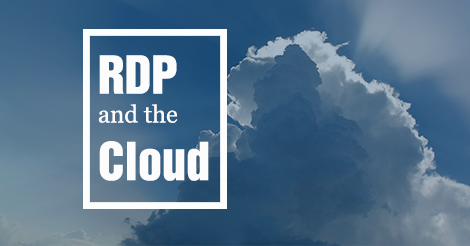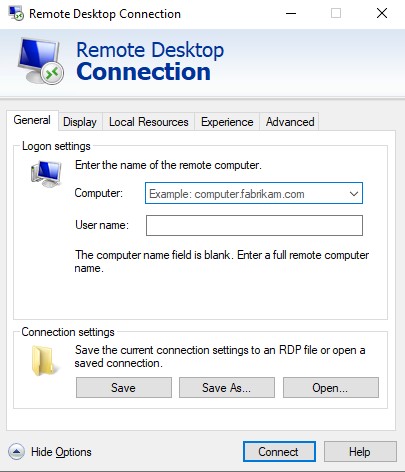What is RDP?
RDP stands for "Remote Desktop Protocol" and it’s a Microsoft licensed technology that essentially allows you to connect from your device to another computer over the internet. The technology is available for a large range of computers, tablets and other devices, including most Windows and Mac computers, iPads and iPhones, Android devices, and systems running Linux or Unix.
It sounds complex, but it’s not.
What it allows you to do, over the Internet (or over a local area network, or both), is to use one of the above devices to run all kinds of software which physically resides on one or more servers somewhere else – and NOT on your computer or device. In order to do this, you simply need to have the RDP Client software or app (such as Remote Desktop Connection pictured below which is a free application that comes standard on most Windows computers) while the other computer that you’re remotely accessing needs to run RDP server software. The RDP Client that's actually installed on your computer, tablet, phone, etc. is commonly referred to simply as Remote Desktop or RDP.
There are many obvious advantages to this - like being able to access a Windows program from an iOS device or a Mac, to being able to run software that requires powerful processors and lots of memory from a minimally configured workstation. The concept further allows system managers to install and manage key software, such as ERP software, on a single computer (the server) and not have to install and refresh that software on dozens or hundreds of individual workstations.
Logically, then, RDP is frequently used to make software available on the cloud/SaaS as is the case with Blue Link. Blue Link’s software is installed on our powerful servers and equipment and managed by our team of in-house experts. Your company can then access the system using RDP from your own devices either at your office or while working remotely.
What is the Cloud?
There are many definitions, but the one I like is "life without a hard drive". Basically the cloud is a term for using software, and saving and retrieving data, files, and information, from computers, storage devices and servers that you neither own nor see, but that you access remotely over the Internet. To be clear, these programs and this data is stored on hard drives, and run on computers, but they are typically physically located in a data center somewhere else, and in many cases are spread geographically among multiple servers and storage arrays. And there are numerous ways to interact with the cloud, including your web browser, RDP, specific tools like music streaming apps, and many others.
Some people mistaken cloud computing with web-based applications. Web-based applications are like signing into your online banking or Netflix for example. You can sign in from anywhere with an internet connection (Just like with an RDP connection) but some of the differences between web-based programs and cloud-based programs are security and maintenance. When there is a new release for Netflix, all customers get the release at the same time and all customers are covered by maybe MFA security. But with cloud-computing, your company's data is stored on a specific server with multiple levels of security and maintenance happens on a server by server basis.
An RDP Connection allows you to access the Cloud.
So then, what is SaaS?
SaaS stands for Software as a Service. What does that mean? There are many variations, but it most commonly applies to describe software that is licensed on a subscription basis, as opposed to an up-front license fee, and is hosted on the software provider's servers (or servers leased by the software provider), and not on the subscriber's own equipment. That will usually also shift responsibility for data backups and hardware maintenance from the software user to the provider. In short, users pay on a regular basis to access software that is managed and installed on the vendor’s equipment.
So, putting it all together: if you're looking at implementing a new ERP software system, one option you have is to go the SaaS route. If you do, then you're using the Cloud, and you may very possibly be using RDP on your PC or iPad.











